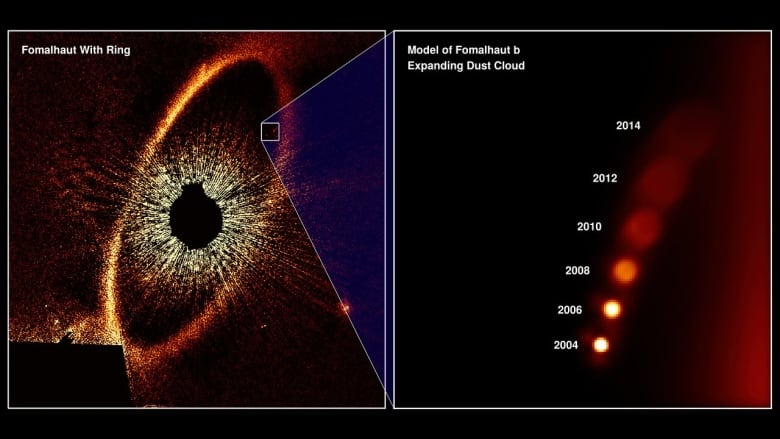In 2008, NASA announced that a new exoplanet was found orbiting a star 25 light-years away. But now it seems to have vanished.
It turns out that it likely wasn't a planet at all.
The initial observation of the potential exoplanet, named Fomalhaut b, was made in 2004 using the Hubble Space Telescope, with follow-up observations in 2006.
The host star, Fomalhaut, has long fascinated astronomers. The star is found in the southern constellation Piscis Austrinus and is surrounded by a cloud of dust. Images reveal it to look like the fictional Eye of Sauron in the movie The Lord of the Rings.
While most exoplanets are discovered through the transit method — when a star's light dips ever so slightly as the planet crosses in front of it — this was directly observed by Hubble. And the dot appeared to be moving, thus supporting evidence of an exoplanet.
But additional observations by Hubble in 2014 revealed ... nothing.

This exoplanet wasn't making any sense at all.
"Fomalhaut b has always been a mystery," Andras Gaspar, an astronomer at the University of Arizona and corresponding author of the new paper published in the journal Proceedings of the National Academy of Sciences, said in an email. "For starters, its colours were a bit off from what one would expect from a massive exoplanet."
But stranger still, in Hubble's initial images, the "planet" was bright in visible light but produced no heat signature in infrared light, as an object like this should. Some of the hypotheses for this was that there could be a ring of dust around Fomalhaut, or the planet was similar to Saturn and itself sported a massive ring.
Then Gaspar and corresponding author George Rieke looked through data and realized that Fomalhaut b wasn't where it was supposed to be, which further piqued their curiosity.
What Hubble actually witnessed
Their paper concludes that instead of an exoplanet, what Hubble witnessed was a rare collision between two large, icy asteroids that produced fine dust particles.
Following recommendations from one of the reviewers of their paper, they went back and analyzed the object and noticed that it was expanding, further strengthening their case of an expanding cloud of dust.
Capturing something like this is rare. It just happened to be a case of Hubble looking in the right place at the right time. But it's not without precedent, Gaspar said.
"Sometimes we do get lucky and see an unlikely event," he said. "Humans have observed and noted quite a few supernovae going off over the last millenia; we have seen the Shoemaker-Levy 9 comet impact Jupiter; the massive Tunguska impact [in Siberia] in 1908 went undiscovered for years."

Catching something of this magnitude is important for understanding how planets and star systems form.
"The Fomalhaut system is the ultimate test lab for all of our ideas about how exoplanets and star systems evolve," Rieke, also from the University of Arizona, said in a statement. "We do have evidence of such collisions in other systems, but none of this magnitude has ever been observed. This is a blueprint for how planets destroy each other."
Rieke and Gaspar have booked time for follow-up observations on the upcoming James Webb Space Telescope, set to launch in 2021.
"Witnessing such an event, as rare it is, is fascinating. The Earth-moon system formed in a massive collision (much more massive than this)," Gaspar said. "Collisions produce the asteroid fragments that impact Earth to this day and provide us with shooting stars to see at night, and large asteroids that movies have taught us to fear and that we are actively searching for."
https://news.google.com/__i/rss/rd/articles/CBMiQWh0dHBzOi8vd3d3LmNiYy5jYS9uZXdzL3RlY2hub2xvZ3kvZXhvcGxhbmV0LWRpc2FwcGVhcnMtMS41NTQyNzU50gEgaHR0cHM6Ly93d3cuY2JjLmNhL2FtcC8xLjU1NDI3NTk?oc=5
2020-04-26 08:00:00Z
52780748067649
Tidak ada komentar:
Posting Komentar